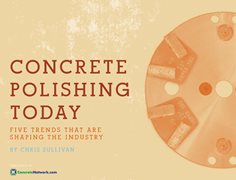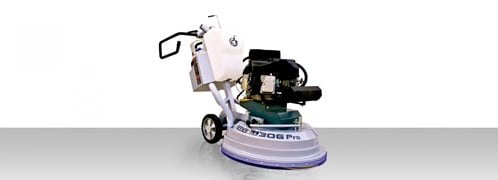- Concrete Polishing Equipment
- Get the Look - Polished Concrete Pictures
- How to Polish Concrete: Learn the basics and get a step-by-step overview
- Polished Concrete Preparation: How to clean, repair, and evaluate before polishing
- Concrete Polishing vs. Resurfacing
- Reviews of Concrete Polishing Equipment How to clean, repair, and evaluate the condition of concrete floors before polishing
- Tips on Using Polishing and Grinding Equipment
- Tips for Choosing Edge Grinders
- Selecting Dust-Collection Equipment
- Diamond Tooling: Tips for choosing the right type of diamond tooling and equipment
- Concrete Densifiers: An introduction to chemical hardeners and how they work to improve polished concrete
- 2023 Polishing Techniques: An online interview series featuring Bob Harris
Wet vs. Dry Concrete Polishing: Taking a Hybrid Approach
Many installers have adopted a hybrid approach to polishing, using both wet and dry methods as the job warrantsThis is an excerpt from the new e-book “Concrete Polishing Today,” part of a series of reports from ConcreteNetwork.com on trends and insights about decorative concrete applications.
Concrete Polishing Today

Discover five developing trends in concrete polishing from ConcreteNetwork.com’s new e-book. You’ll also get insights and guidance from veteran polishers that will help you stay profitable in today’s market.
Download Concrete Polishing Today (PDF)
Polishing concrete is a process that can take place wet or dry. Depending on who you talk to and what region of the country you are in, one process seems to rule over the other. Both have their pros and cons, but in the end, they each produce a high-quality polished floor when done properly.
“You see a lot of the old-school terrazzo guys use a wet polish because that is what they are used to,” says Brad Walker, owner of Lone Star Decorative Concrete, Watauga, Texas. The advantages of wet polishing include a reduction in airborne dust and less wear and tear on diamond tooling because of cooler processing temperatures.
On the other side of the fence, those that prefer dry polishing claim that the wet process consumes a lot of water, especially on large jobs, and produces a significant amount of waste slurry that is not always easy to dispose of. “Environmental issues are a growing concern, and disposing of slurry from wet polishing is becoming an issue,” says Walker.
Dry polishing may not consume water, but it does produce a significant amount of airborne contamination -- enough so, that many commercial jobs require dust collection on the job as part of the polishing process. This almost mandates that if you are going to polish dry, you will need to own vacuum equipment. “Vacuum equipment has gotten much better,” says Walker. “Hepa filters and better pull make vacuum equipment that is lasting longer.” One of the reasons some contractors prefer dry over wet polishing systems is the ability to dispose of the waste more easily. The downside to dry polishing is the cost associated with having to own and operate vacuum equipment as well as increased tooling costs, since dry polishing tends to consume diamond pads faster than wet polishing.
Many installers have adopted a hybrid approach to polishing. They prefer one process over the other, but remain flexible and are willing to adapt when the situation warrants. “We wet grind the floor open on a lot of our jobs, then switch over to dry polish for the rest of the job,” says Walker. This strategy of doing what works best in a particular situation seems to be common among polishing contractors who are not married to one process.
If there ever was a place where art and science come together in decorative concrete, the polished concrete industry is it. The process of when, how and what in regard to actually polishing the floor is as much an art form as it is a set of steps to achieve an end result. Each installer follows his own recipe that has evolved from years of trial and error. “Polishing is an art form - the floor will dictate the type of diamonds that need to be used and if a wet or dry polish is required,” says Talbot, Vernon Talbot, managing director of Retro Plate Inc., Provo, Utah.
Related informationPolishing Basics
Wet vs. Dry Polishing
Return to Concrete Polishing Today
 Polishing Diamonds
Options for hard, medium, and soft concrete.
Polishing Diamonds
Options for hard, medium, and soft concrete.
 CPS G-170 Electric
17" Floor Grinder 230 volt ($7,600)
CPS G-170 Electric
17" Floor Grinder 230 volt ($7,600)
 Propane Concrete Polisher
Concrete Polishing HQ
Propane Concrete Polisher
Concrete Polishing HQ
 Scanmaskin Diamond Tools
A wide variety of different sizes and hardness
Scanmaskin Diamond Tools
A wide variety of different sizes and hardness
 Lythic Densifier XL
1 Gallon & 5 Gallon sizes
Lythic Densifier XL
1 Gallon & 5 Gallon sizes




